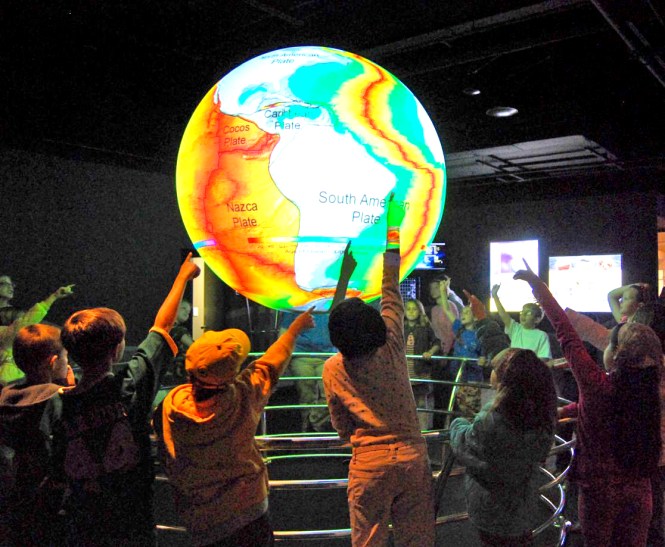
Teachers Exploring TACC
Education and technology has changed the way we are involved with museums. There are many museums that people may never get to visit. Virtually, there are resources to help students, teachers and community to use museums to learn. One resource that is wonderful is the Google Cultural Institute
I share this blog because often a museum trip is a quick hit and in the words of Mrs. Basil E. Frankweiler, the kids don’t really see much on the trip. So I offer you some ways of seeing, visualizing and being involved in learning.
The Google Cultural Institute has many ways of sharing collections, tours, and artifacts.
Wikipedia says:
“‘Google Cultural Institute is an initiative unveiled by Google following the 2011 launch of the Google Art Project. . It is “an effort to make important cultural material available and accessible to everyone and to digitally preserve it to educate and inspire future generations.” The Cultural Institute has partnered with a number of institutions to make exhibition and archival content available online, including the British Museum, Yad Vashem, the Museo Galileo in Florence, the Auschwitz-Birkenau State Museum, and the Museum of Polish History in Warsaw among others. Further you can :
Discover exhibits and collections from museums and archives all around the world. Explore cultural treasures in extraordinary detail, from hidden gems to masterpieces.
Create your own galleries and share favorite finds with friends.You can take a tour, Discover artworks, world heritage sites, cultural figures, and more. You can create your own..
Create your own galleries and share favorite finds with friends and take virtual tours.
Participants can Explore & Search
Explore to discover more categories and projects.
Or search for people, events, museums, and works of art.
You Can Share & Discover. This is a hearth. How would you cook on this? That information is available in the Google Cultural Institute.

Share special finds with friends across all your social networks.
Compare two items side-by side.
Save favorite pieces and access them later, and even create your own gallery.
Or click Discover to see related topics and categories.
The Iron Age in Britain
I was a visitor to the British Museum and shared a few pictures with Facebook.There was so much to see and learn about. I found a new section to explore. Life in the Iron Age of Britain was fascinating. But there was not enough time to study the whole collection.
I live in Washington , DC within walking distance of most of the Smithsonian Museums . It is always hard to choose which museum to visit and to grasp the new offerings. An entirely new offering is the 3-D Explorer.
You can explore online resources from A to Z online.
The Smithsonian has a new 3-D Explorer. They are excited about it.
Smithsonian X 3D launches a set of use cases which apply various 3D capture methods to iconic collection objects, as well as scientific missions. These projects indicate that this new technology has the potential not only to support the Smithsonian mission, but to transform museum core functions. Researchers working in the field may not come back with specimens, but with 3D data documenting a site or a find. Curators and educators can use 3D data as the scaffolding to tell stories or send students on a quest of discovery. Conservators can benchmark today’s condition state of a collection item against a past state – a deviation analysis of 3D data will tell them exactly what changes have occurred. All of these uses cases are accessible through the Beta Smithsonian X 3D Explorer, as well as videos documenting the project. For many of the 3D models, raw data can be downloaded to support further inquiry and 3D printing. This video explains the topic.Some historic artifacts have been placed in this model and can be printed out in a classroom, or examined online to think about the model.

If you come to Washington , DC , the problem is , which museum to visit. I like the Natural History Museum with the Science on a Sphere exhibits that help us understand the whole museums focus on the Earth.
The Smithsonian Museums are competitive .
One of my favorite museums that wraps itself around you is the Monterey Bay Museum.
The Monterey Bay Aquarium (MBA) is a public aquarium located in Monterey, California, United States. The aquarium was founded in 1984 and is located on the site of a former sardine cannery on Cannery Row. It has an annual attendance of more than two million visitors. It holds thousands of plants and animals, representing more than 600 species on display. The aquarium benefits from a high circulation of fresh ocean water which is obtained through pipes which pump it in continuously from Monterey Bay.

The centerpiece of the Ocean’s Edge Wing, is a 28-foot-high (8.5 m), 333,000-US-gallon (1,260,000 l; 277,000 imp gal) tank for viewing California coastal marine life. In this tank, the aquarium was the first in the world to grow live California Giant Kelp. Visitors are able to inspect the creatures of the kelp forest at several levels in the building. The largest tank in the aquarium is a 1,200,000-U.S.-gallon (4,500,000 l; 1,000,000 imp gal) tank in the Open Sea galleries (formerly the Outer Bay), which features one of the world’s largest single-paned windows. It is one of the few aquariums to hold the ocean sunfish in captivity.
Sealife on exhibit includes stingrays, jellyfish, sea otters, and numerous other native marine species, which can be viewed above and below the waterline. The Monterey Bay Aquarium is one of very few in the world to exhibit both bluefin and yellowfin tuna. For displaying jellyfish, it uses a Kreisel tank, which creates a circular flow to support and suspend the jellies. The aquarium does not house mammals other than otters. These are a few of my favorite museums to share.
Other options? Sure
New? Augmented reality and the Hololens. This is how Microsoft wants to change the superbowl. Immersive Superbowl.??
There is of course Google Cardboard, and the use of Skype to talk to people in museums or classes from another country. We don’t want to just look at pretty pictures. Content makes the viewing much more memorable than eye candy.

To be in the museum in Monterey and to see this Octopus is one experience. Coming now are ways that are immersive , in that the virtual reality puts the person into the experience, well sort of. Here is a teaser. A GIF
http://www.montereybayaquarium.org/-/m/images/animated-gifs/kelp-forest.gif?la=en( in case you want to download it.)
Here is one that I find especially awesome. the whale by Magic Leap. Amazing 3D Virtual Reality Leaping Whale. There are other examples within that URL that are awesome.
.
www.magicleap.com This one has some other fascinating models. It does take a little bit of time to load. Be patient.
The virtual reality tool that I most liked was Google Glass. I could see my way through Russia , have translations, a way of going through the subways. I am sure that it will be back in another form. I can’t wait.





[…] Sourced through Scoop.it from: thepowerofus.org […]